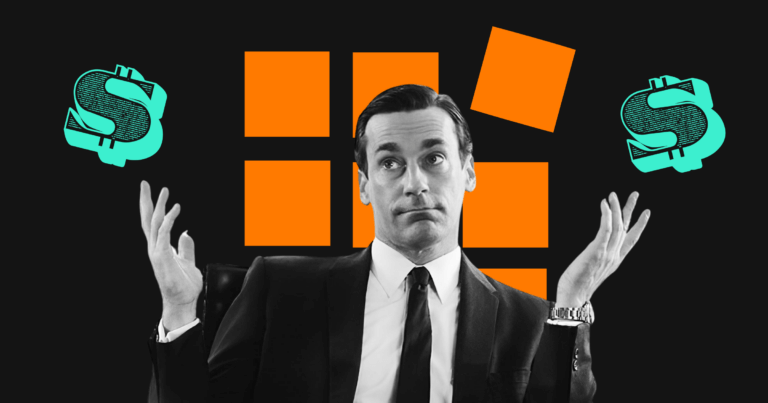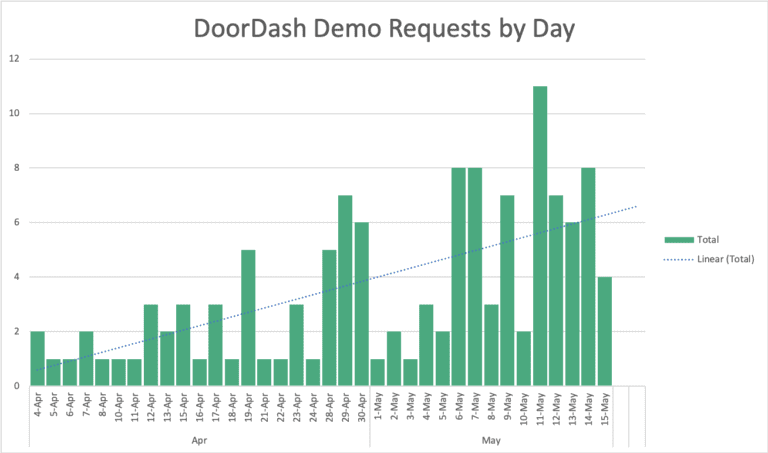Is paid social advertising still worth it in 2023?
Let me tell you a story.
I began working for Armorblox in 2019, and my job was to drive pipeline. I was the Director of Revenue Operations & Demand Generation Strategy. Like almost every B2B company on the planet, I knew my success would hinge largely on paid social advertising.
So, I did what any demand generation marketer would do in my situation: DIY’d some LinkedIn ads using the platform’s native tools. (Note: I sprinkled in some Google Search ads, too.) After a few months, my cost per lead (CPL) was $3k, and I was in a frenzy. While our average account value (ACV) was much higher than that, I knew this level of spending wasn’t sustainable.
My next move? I hired an agency. Hey, maybe I just didn’t have the chops to catch our customers’ attention on LinkedIn. I was okay admitting that.
After a few months, still nothing, and at that point, I was convinced our audience either wasn’t on social media or they didn’t want to hear from us. Either way, I was ready to launch paid social into the sun—until I met my now-teammate Joe Hill.
He said, “Abdallah, give Metadata six months. We’ll run some experiments, figure out what your audience likes, and go from there. If it still isn’t working, I’ll grab a shovel and help you bury paid social for good.”
Joe didn’t actually say that, but our conversation did kickstart my fascination with Metadata. I work for them now, so you can also probably guess how those six months went.
Why would I share this story with you? Because ever since we released our 2023 Paid Social Benchmark Report earlier this year, I’ve sensed skepticism from marketers—the same skepticism I felt a few years ago.
This article is my way of addressing (and hopefully squashing) those doubts.
But Abdallah, paid social is sooo expensive
I want to remind you of my CPL at Armorblox: $3k. I know. Absurd.
While the average CPL on Facebook and LinkedIn from our benchmark report didn’t come anywhere close to that, I still see why you may be struggling to swallow the cost of paid social, especially in a down economy.
For reference, here’s what the average CPL on Facebook and LinkedIn looked like from April 2022 – April 2023:
- LinkedIn: $123.85
- Facebook: $102.02
If you’re tracking metrics closer to pipeline and revenue, that’s great. Our benchmark report found the average cost per opportunity (CPO) on LinkedIn and Facebook to be $3,162.89 and $4,950.64, respectively.
Those numbers can eat into your budget quickly, but accepting that you’re locked into that CPL or CPO forever and writing off paid social as “too expensive” is a mistake.
Your CPL or CPO after a few campaigns are just your benchmarks. While they’re solid leading indicators of success, they shouldn’t determine paid social’s fate.
To truly grasp the cost of paid social, you need to run a helluva lot of experiments. More specifically, you must experiment with the three As: audience, ads, and assets.
- Audience: Figure out which audiences convert and which don’t
- Ads: Test the ad design, copy, and call to action (CTA)
- Assets: Experiment with the offer type, e.g., webinar, incentivized demo request, etc.
Run your experiments in that order, and don’t stop until you have a clear picture of how paid social advertising impacts pipeline and revenue.
That’s what we did at Armorblox. Seriously. We started with 143 experiments and whittled it down to 25 as we got a better understanding of what resonated with our audience.
If you wrap up your experiments and still aren’t vibing with the price tag and impact of social ads, then maybe paid social isn’t for you. But don’t assume it’s not until you have definitive proof.
That said, getting that definitive proof—for or against paid social—will take time, but I’d wager a big bet that once you find your sweet spot, your North Star metrics will soar.
Ours certainly did at Armorblox:
- 120% increase in triggered opportunities
- 49% decrease in cost per triggered opportunity
- 105% increase in lead to triggered opportunity
One more thing: Even if you consider social media a cost-efficient channel, keep experimenting and dive deeper into your audience—there’s always more to discover.
But Abdallah, my go-to lead gen tactics aren’t working
My lead gen tactics aren’t working was a phrase deeply entrenched in my vocabulary at Armorblox. Before meeting Joe, I’d lost faith in lead gen. It was dead to me.
I know many demand generation marketers are in the same boat and struggling to stay above water, either because their tactics aren’t generating cost-efficient leads or because the leads don’t turn into revenue (or a mix of both).
If you’re second-guessing your tactics, ask yourself: Which tactics aren’t working, and what are their goals?
Lead generation is an umbrella term that encompasses tactics and strategies far and wide. Are some of the tactics losing their luster? Sure, but many are thriving.
So, if your tactics aren’t working, it might simply be because you’re generating leads that have no business converting. For example, leads from gated content or a webinar won’t have an immediate impact on your bottom line. Maybe they used to, but they don’t anymore.
The lead generation tactics working today are the ones that target audiences at the bottom of the funnel.
Getting to that point requires tactical switches, like embracing different channels and ad types. Still, it primarily relies on building better audiences, which Joe Hill outlines in his article, Building B2B Audiences Across Native Ad Channels with Metadata.
Joe’s approach is simple. To build better B2B audiences, ask yourself two questions:
- Which companies do I want to reach with my ads?
- Which people at those companies should see my ads?
With those answers, you can collect target companies (URLs) and job titles and create an audience list that’s 100% relevant to your business. I guarantee your lead gen tactics will flourish if you do this.
It doesn’t matter if paid social is currently in the dog house or not, one thing will always be true: The better you know your audience, the better your campaigns will perform.
Building audiences in Metadata
This article isn’t a sales pitch, but I want to touch on how easy it is to build 100%-relevant audiences in Metadata.
This screenshot should do most of the talking:

What does this screenshot show? The sources you can use to build relevant audiences like:
- User-generated data (the same data in the native channels)
- Data providers, e.g. Aberdeen, Bombora, and Leadsift (unique to Metadata)
With these Metadata sources, you can tap into user-generated data and layer firmographic (company size, revenue, industry, etc.), technographic (tech stack), and intent data. You can even add first-party data from Salesforce and HubSpot to guarantee you aren’t wasting your budget on people who aren’t ready to buy.
With a tool like this, you do things like:
- Grow pipeline by targeting companies with open opportunities
- Cross-sell to customers and get them thinking outside their current product use case
- Set your sights on high-risk accounts with precise messaging
This is what’s possible with 100%-relevant B2B audiences.
But Abdallah, there are so many channels these days
There are a lot of channels, and new ones are popping up daily. Some channels, like TikTok, stick. Others, like Quibi, not so much. Either way, you have a lot of places to spend your budget.
I see that as a good thing because you should never put all of your eggs in one basket. It’s too risky.
Honestly, even if we reduced Metadata’s CPO on LinkedIn to $100, we still wouldn’t pour every penny into the channel. There would be some heavy pours into the channel, but we’d shut off the tap at some point.
Not only does an all-in mindset epitomize unnecessary risk, but it also overlooks the other channels your customers and prospects rely on to make buying decisions—think Reddit, Twitter, Facebook, YouTube, Instagram, and TikTok.
For younger generations, namely Generation Z, TikTok is their search engine of choice. While that may not immediately translate to B2B, it will eventually—especially as more B2B marketers embrace TikTok as a gateway to their customers.
It’s on you to experiment, see what works, and expand into new channels that keep your campaigns fresh and costs low.
If you look at Armorblox’s playbook, you’ll see this is exactly what we did. After successfully scaling incentivized demos on LinkedIn (see one of the ads below), we used MetaMatch to take our campaigns to Facebook.

What happened? More eyes on our ads for a 61% decrease in cost per click (CPC) and a 76% decrease in cost per mille impressions (CPM).
Please don’t jump to conclusions
Kicking paid social to the curb without significant thought is no different than draining your 401k without exhausting other options first.
There’s a lot of “paid social is dead” talk, and yes, some of the data in our benchmark report fuels that rhetoric. Whatever. Paid social isn’t a silver bullet; it might not work for everyone.
But you can’t bid it farewell simply because others tell you to or because a few sub-par campaigns cost you more than you wanted to spend. You need to look at your campaigns from every angle, intimately understand your audience, run experiments at scale, and deliver ads with offers that resonate.
If you check all of those boxes and still aren’t happy with the ROI of paid social, then okay, I won’t argue with you. Maybe paid social advertising is dead (at least for your business).
I don’t see you coming to that conclusion, though. Paid social just has too much going for it, and no amount of naysayers will change that.


